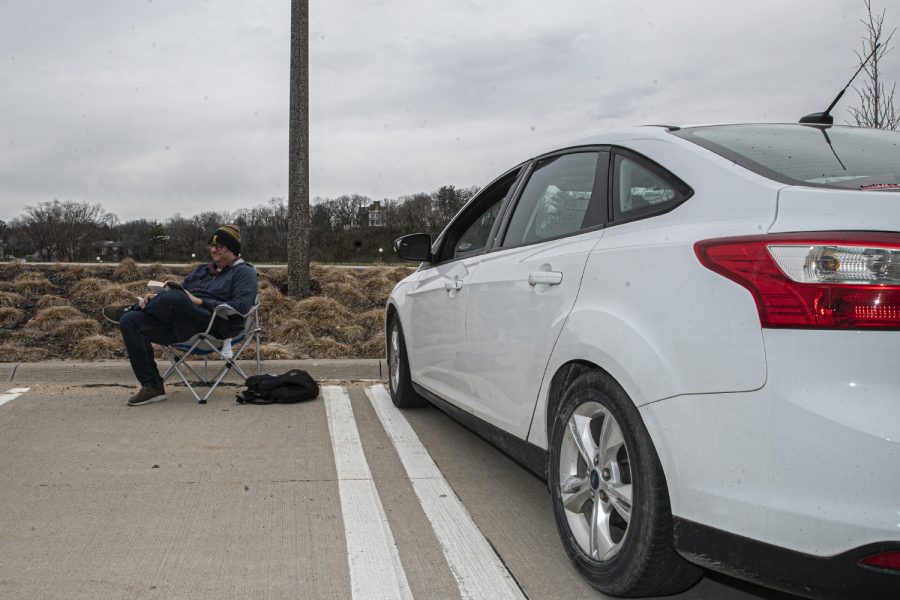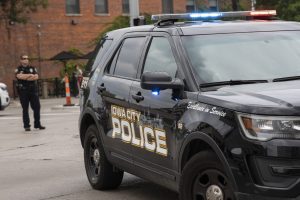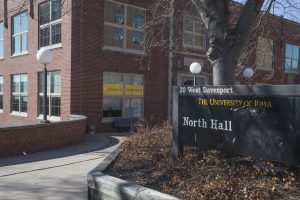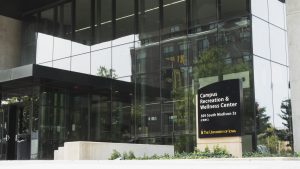University of Iowa drive-up Wi-Fi locations a ‘Band-Aid’ fix for larger problems of digital divide
While drive up WiFi centers are one attempt at bridging the digital divide and making broadband internet services more accessible to students, staff, and faculty, they only scratch the surface of a much larger issue.
University of Iowa graduate student Philip Zaborowski does homework in the parking lot of Hancher Auditorium on Tuesday, April 2, 2020. As a result of COVID-19 creating a sudden influx of at-home work, the university attempted to aid in the congestion of internet traffic by installing free Wi-Fi in the Hancher parking lot.
September 16, 2020
More than three-quarters of University of Iowa classes have an entirely virtual format, and internet access is no longer a luxury as COVID-19 continues to impact education.
While 88.2 percent of Iowans have access to broadband internet 100mpbs or faster, Iowa is currently ranked 45th in state broadband access.
“Digital divide –– that means you have technology haves and technology have-nots,” said John Achrazoglou, clinical associate professor and chief technology officer in the UI College of Education. “Internet access, high speed, high quality internet access is no longer an extravagant treat. It’s an essential piece of life, of work, learning, and play.”
There are many rural areas in the state that could not even get high-speed internet if they wanted, Achrazoglou said, and technical difficulties are inevitable no matter where you are.
One solution the UI offers is drive-up Wi-Fi centers on campus. In an email to The Daily Iowan, Communications Officer for the UI Office of the Chief Information Officer Nicole Dahya said this has been a popular option for members of the UI community who need WiFi but do not feel comfortable going into campus buildings.
“People can walk, bike, take a bus, etc. and utilize the Drive-Up Wi-Fi service (practicing appropriate social distancing and safety measures, of course),” Dahya said. “We have also expanded outdoor wireless service to Hubbard Park and the Pentacrest, and are working to add it to the T. Anne Cleary Walkway.”
Achrazoglou said these Wi-Fi spots were a good start, but not a permanent solution to the technology access issue.
“The number one issue that we have is getting high speed internet access to all different students.” Achrazoglou said. “They go home and they might not have that anymore, well, what are they going to do?”
UI Clinical Associate Professor Stephen Cummings, who is also the distance education administrator for the UI Social of Social Work, said while he supports the option because it is a solution at a local and institutional level, it is not optimal for learning.
“At best it’s a Band-Aid, something we are offering,” Cummings said. “But the issue isn’t just with the university, it’s with a larger approach to how we even do this technology.”’
The divide has always been there for lower income households and people, he said, and it is harder for them to pay for broadband. In rural communities, it’s much harder to connect digitally to do anything, he said.
“We could offer the best program on Earth,” Cummings said. “And we can pipe it through our infrastructure, but once it gets out to the last mile wherever people are at, they’re still going to struggle getting connected to it.”
Cummings added that while broadband internet structure is still shaky, virtual learning at this scale would have never been possible just a few years ago.
“And that’s not to polish the issue, it’s just to point out that we’re taking advantage of a really fragile infrastructure as it is to convey our courses to include students in this way,” the professor said. “But I hope that we learn a lot about what we need to change as a result of this.”






